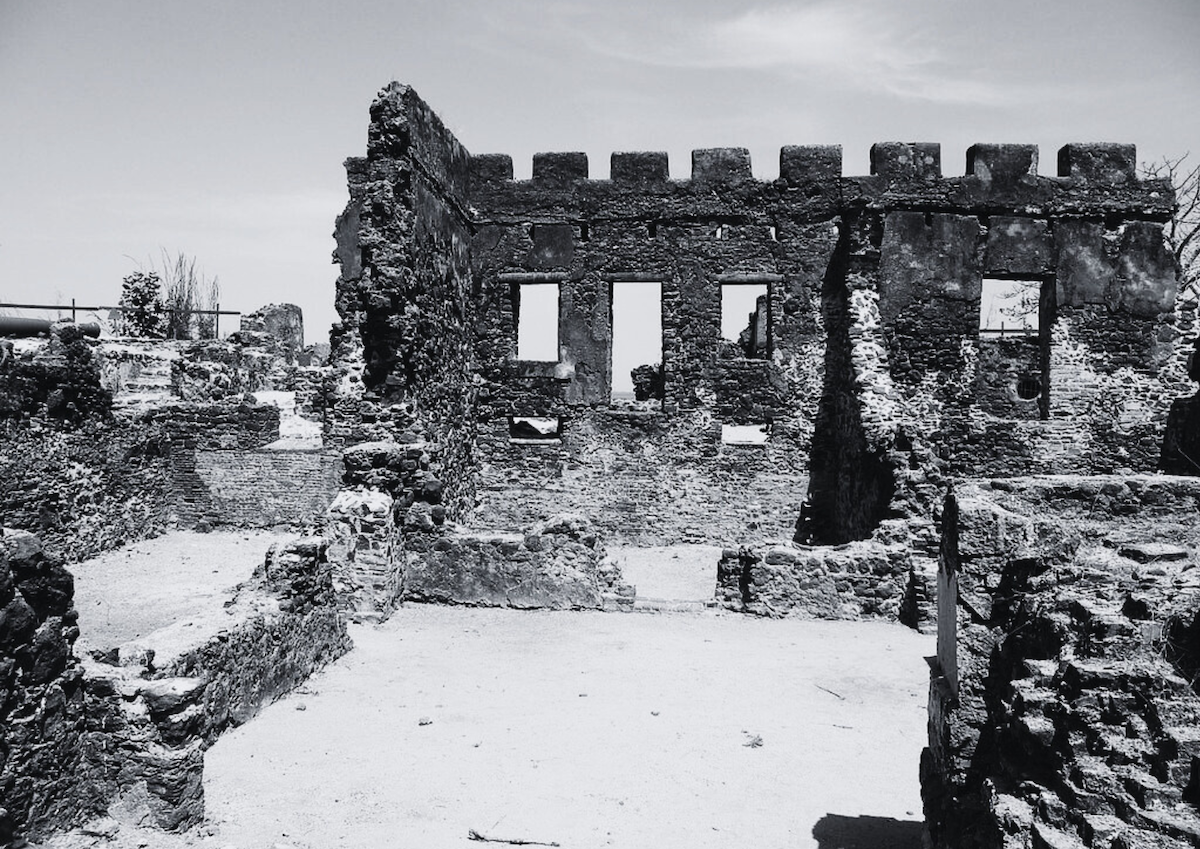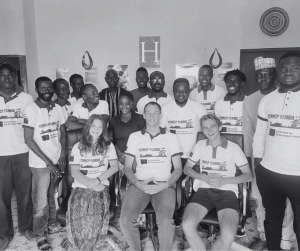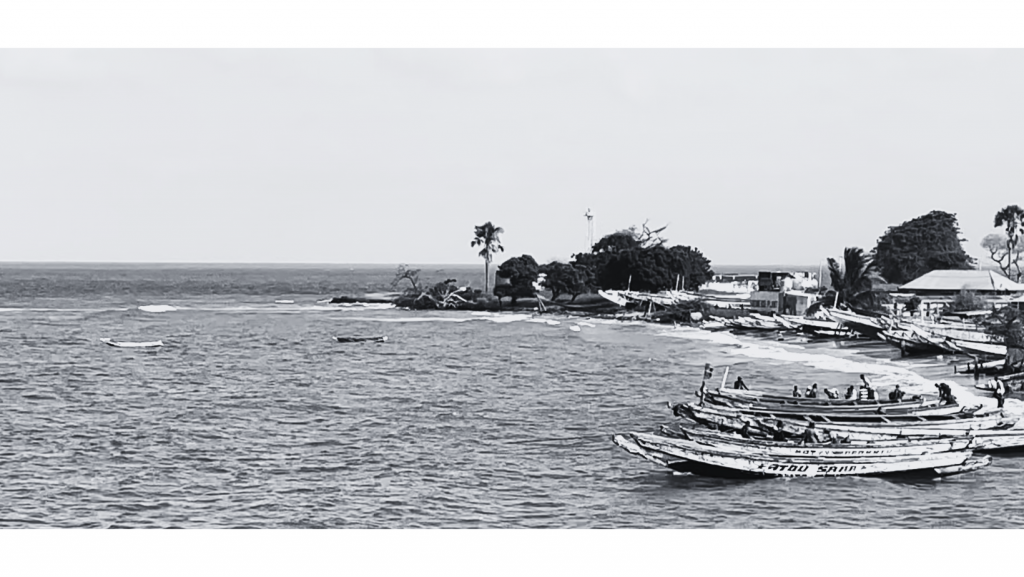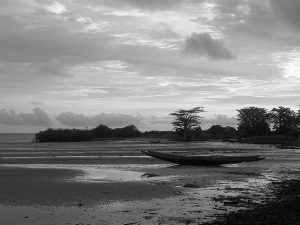Tag Archives: The Gambia
A Street Art Workshop in The Gambia
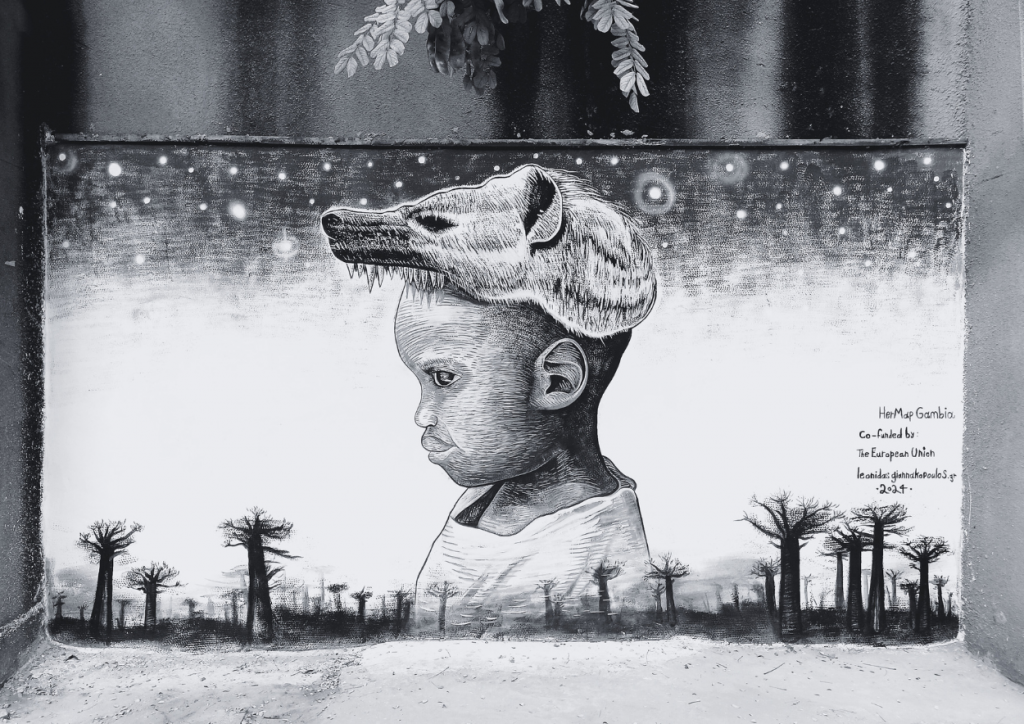
Mural by Leonidas Giannakopoulos, created for the NCAC premises in Banjul, in the framework of HerMaP Gambia, an initiative co-funded by the EU.
From 23rd October to 1st November, HERITΛGE held a Street Art Workshop in the Gambia. Street art serves as a vibrant and dynamic medium to bring history, culture, and identity to life and the workshop aimed to emphasize the power of creative expression in preserving and showcasing cultural heritage. The workshop was led by Leonidas Giannakopoulos*, a Greek artist whose murals adorn a number of central buildings in Greece and beyond. Giannakopoulos also created a mural for the premises of The Gambia’s National Centre for the Arts and Culture (NCAC) during the workshop.
The training is part of HerMaP Gambia, an initiative co-funded by the EU that aims to enrich the understanding and appreciation of Gambian cultural heritage while enhancing the capacity of key stakeholders in the cultural sector. HERITΛGE has been working with the street artists of Galloya, a creative team of young locals that has also put together a local festival, for the past two years in the framework of HerMaP Gambia.
Nine participants from around The Gambia joined the ten-day workshop where they delved into the history, significance, and key movements of graffiti and street art. Through this initiative, the program highlighted the importance of art as both a cultural tool and a means of celebrating and preserving heritage in a living, evolving form.
The workshop explored how cultural heritage can be commemorated through artistic representation, ensuring that elements of heritage resonate with the present generation. They also focused on practicing essential techniques like stencilling and design principles. On the third day, they focused on personal production, allowing each participant to create their own unique artwork.
“I really enjoyed the big thirst for knowledge all our participants had and I hope everything I showed them and taught them was inspiring. I believe they will use all this knowledge because I saw a big thirst for artistic expression. In their next works I believe they will apply all the things that they learned and they will keep on learning!” said trainer Leonidas Giannakopoulos.
Participants were enthusiastic and fully engaged, producing creative and thought-provoking street art reflecting local culture. “The knowledge and skills we gained during this experience have been truly invaluable” said Amadou Mousa, a street artist from Galloya and one of the founders of the local festival. “Leonidas’ guidance has not only enhanced our artistic abilities but also inspired us to explore new ways of expressing creativity within our community,” he added.
Following this intensive workshop, an additional five days were devoted to the creation of a public artwork at the NCAC premises. During this time, participants observed advanced techniques and engaged closely with the detailed process of producing impactful public art. They gained hands-on experience in conceptualization, production, and project management, enhancing their appreciation for the commitment and precision behind large-scale street art projects.
“I wanted to create an artwork that refers to the people here in The Gambia, to the country’s young people that bring the future,” said Giannakopoulos. “So I wanted to paint the portrait of a young child from the area of Banjul and express the culture of this country by painting him with a mask of a hyena over a landscape of baobab trees, a very powerful tree that gives so many things to the people, it is not only about food or drink but is also spiritual.”
*Leonidas Giannakopoulos studied painting and printmaking at the School of Ffine Arts of Athens, and has since been commissioned to paint several murals for municipalities, festivals, public buildings and private companies around the world.
**Photos by Leonidas Giannakopoulos, Nefeli Papanagiotou, and the HerMaP Gambia team and beneficiaries in The Gambia
The significance of Kunta Kinteh island and related sites
By Ebrima Jammeh*
The Gambia is the smallest country on mainland Africa, with a population of about 2 million people. It is often referred to as the smiling coast of Africa due to the friendly nature of its people. It is surrounded on all three sides by Senegal (North, South, and East) except the West, which is occupied by the Atlantic Ocean, and is divided into two halves (North and South) by the River Gambia (a freshwater river).
Having gained independence from the British in 1965, it became a Republic in 1970 under the Leadership of President Dawda Kairaba Jawara.
Kunta Kinteh Island and Related Sites: Outstanding Universal Value
Kunta Kinteh Island, formerly known as James Island, and its related sites, are a testimony to the encounter between Africa and Europe along the River Gambia, a period stretching from pre-colonial and pre-slavery times to independence. The site is particularly significant for its relation to both the beginning of the slave trade and its abolition and also documents early access to the interior of Africa.
Kunta Kinteh is a small island in the Gambia River which flows out into the Atlantic Ocean. The island’s location made it a strategic place to control the waterway. Visited by explorers and merchants in their search for a sea route to India, it became one of the first cultural exchange zones between Africa and Europe. By 1456 the Island had been acquired by Portugal from local rulers and the construction of a fort began. Kunta Kinteh Island and Related Sites form an exceptional testimony to the different facets and phases of the African-European encounter, from the 15th to the 19th centuries. The River Gambia was particularly important forming the first trade route to the inland of Africa. The site was already a contact point with Arabs and Phoenicians before the arrival of the Portuguese in the 15th century. The region forms a cultural landscape, where the historic elements are retained in their cultural and natural context. The properties illustrate all the main periods and facets of the various stages of the African-European encounter from its earliest moments in the 15th Century through the independence period.
The main focus of the Kunta Kinteh Island site was the control of the hinterland and its riches rather than control of the coast and the trade that passed along it.
The specific location of Kunta Kinteh Island and its Related Sites, at the mouth of the Gambia River, is a tangible reminder of the story of the development of the Gambia River as one of the most important waterways for trade of all kinds from the interior to the Coast and beyond. The specific, important role of the site in the slave trade, both in its propagation and its conclusion, makes Kunta Kinteh Island and its Related Sites an outstanding memory of this important, although painful, period of human history.
The property includes Kunta Kinteh Island Fort and a series of sites associated with the early European occupation of the African continent. The ensemble has seven separate locations: the whole of Kunta Kinteh Island, the remains of a Portuguese Chapeland of a colonial warehouse (CFAO Building) in the village of Albreda, the Maurel Frères Building in the village of Juffureh, the remains of the small Portuguese settlement of San Domingo, as well as Fort Bullen and the Six-Gun Battery. Fort Bullen and the Six-Gun Battery are at the mouth of the Gambia River, whilst Kunta Kinteh Island and the other sites are some 30 km upstream.
The development of Kunta Kinteh Island differed greatly from that of the many other forts, castles, and trading posts found in other parts of West Africa in that the main focus of the Kunta Kinteh Island site was the control of the hinterland and its riches rather than control of the coast and the trade that passed along it.
The Six-Gun Battery (1816) and Fort Bullen (1826), located on both sides of the mouth of the River Gambia came much later than Kunta Kinteh Island and were built with the specific intent of thwarting the trade in slaves once it had become illegal in the British Empire after the passing of the Abolition Act in 1807. They are the only known defensive structures in the region to have been built specifically to stop slaving interests. The other fortifications of the region (including Kunta Kinteh Island), were constructed as a means of enhancing and controlling the trade in slaves (and commodities) rather than stopping it. These two military positions allowed the British to take full control of the River Gambia, eventually paving the way for the establishment of the colonial government, a period well-illustrated by many colonial buildings in Banjul and the Governor’s Rest House at Fort Bullen. Finally, Fort Bullen shows evidence of its re-use during the Second World War (1939-1945) as a strategic observatory and artillery post. This later period illustrates yet another European rivalry that spread to the African continent.
The Six-Gun Battery (1816) and Fort Bullen are the only known defensive structures in the region to have been built specifically to stop slaving interests.
Site Significance
Criterion (iii): Kunta Kinteh Island and related sites on the River Gambia provide an exceptional testimony to the different facets of the African-European encounter, from the 15th to 20th centuries. The river formed the first trade route to the inland of Africa, being also related to the slave trade.
Criterion (vi): Kunta Kinteh Island and related sites, the villages, remains of European settlements, the forts and the batteries were directly and tangibly associated with the beginning and the conclusion of the slave trade, retaining its memory related to the African Diaspora.
Integrity: The six parts of the serial nomination together present a testimony to the main periods and facets of the Afro-European encounter along the River Gambia, a continuum that stretched from pre-colonial and pre-slavery times to the period of independence and in particular to the beginning and the abolition of the slave trade, as well as documenting the functions of the early access route to the inland of Africa. The six sites encompass all the key remains.
All the sites except the CFAO and Maurel Frères Buildings are ruins. The CFAO Building has been restored and provided with adequate sea defense. The Maurel Frères Building was restored in 1996 and is in a good state of conservation. The Portuguese chapel and San Domingo are in a state of ruins, but these have been stabilized, with the most endangered parts reinforced in 2000.
The isolated position of Kunta Kinteh Island in the river has conserved its setting to the present day. Fort Bullen is also bordered by the river on one side and a large open tract of land on the other, naturally serving as a buffer zone and helping to preserve its setting. It is in a relatively good state of conservation, though the wall on the seaward side is suffering from sea erosion. Parts have collapsed and 20 metres were rebuilt in 2000. The Six-Gun Battery is in a good state of conservation. The ruined sites need ongoing maintenance if they are not to deteriorate over time.
Authenticity: Kunta Kinteh Island Fort was subjected to destruction on numerous occasions. Since the last time by the French, in 1779, it has remained a ruin with only minor attempts at consolidation and minimizing the effects of sea erosion. The Island is a landmark for all concerned with the slave trade, especially the local community and Africans in the Diaspora. Apart from a short period of re-use during the Second World War. Fort Bullen and the Six-Gun Battery were similarly abandoned in the late 19th century. At San Domingo, there are very few visible remains but the area has considerable potential for archaeological research. The ruins that convey the Outstanding Universal Value are extremely vulnerable to erosion. At the time of inscription to the UNESCO World Heritage List, the ruined sites were seen to be part of a wider cultural landscape that needed protection to protect the setting of the sites and to allow them to be understood.
Protection and management requirements
Kunta Kinteh Island, Fort Bullen and all the significant historic buildings in the Albreda-Juffureh complex are legally protected as National Monuments (1995) under the National Council for Arts and Culture Act, 1989 (revised 2003). The proclamation instrument also establishes a buffer zone for all the sites that should be kept free of incompatible developments with adverse effects on their setting. As National Monuments the historic structures are under the custodianship of the National Centre for Arts and Culture (NCAC) who are responsible for their conservation and upkeep. Day-to-day management rests with the Directorate of Cultural Heritage of the NCAC, which employs a Destination Manager, Showroom attendant, site attendants and caretakers. The Six-Gun Battery is located within the State House grounds and is protected by the Office of the President. The sites also have a 5-year management plan that sets out what is acceptable at the individual site and at the national level. This plan was prepared as a result of the joint effort of ten different national and local organizations, supported by the Africa 2009 program.
The funding used for the management and maintenance of the sites is relatively limited and comes mainly from entrance fees. Every three months, the Head of the Museums and Monuments section of the NCAC performs a physical inspection of the sites. This conditional assessment is carried out with a representative of the local stakeholders and, if possible, with a local guide. A brief report is prepared after each visit and these are summarized in an annual report.
To the visitors, the property has symbolic and emotional significance, as a visit to Kunta Kinteh Island is a pilgrimage to their roots. As a piece of historical evidence, much can be learnt from the Island, and it already forms part of the history and social studies syllabus in Gambian schools.
The property contains very fragile ruins that need to be protected and conserved as the tangible elements that convey Outstanding Universal Value. There needs to be ongoing maintenance, monitoring, and conservation to allow these ruins to have the best chance of survival and be robust enough to withstand the onslaughts of nature.
Challenges Include:
- Inadequate funding to ensure constant preservation
- Climate change factors such as erosion sea level rise, weathering
- Treasure hunting
- Inadequate capacity building among the staff
Strengths: The local community is being engaged at all levels while The Gambia has in place an effective and efficient legal framework in the management system. The site’s staff is a committed team that is receiving training in heritage management from the NCAC’s partner organization, HERITΛGE, through its HerMaP Gambia program, co-funded by the European Union.
PARTNERS
The National Centre for Arts and Culture partners with the following:
HERITΛGE through its HerMaP Gambia program that is co-funded by the European Union.
UNESCO
NATCOM
Coalition of Sites of Conscience
African World Heritage Fund (AWHF)
Gambia Tourism Board (GT BOARD)
Gambia Tourism and Hospitality Institute (GTHI)
*Ebrima Jammeh is Destination Manager for The Gambia’s National Centre for Arts and Culture (NCAC). This work was first presented at the 5th World Heritage Site Managers Forum that took place earlier this year in Saudi Arabia.
Digitizing Gambia’s Heritage: A workshop in Digital Tools for Cultural Heritage
HERITΛGE is pleased to announce the successful completion of a transformative workshop that trained heritage caretakers in The Gambia on the latest digital tools for cultural heritage management. Our “Digital Tools for Heritage Management” workshop took place in Barra, Gambia, from December 12th to 18th, 2023. It is part of the HerMaP Gambia program, co-funded by the European Union and implemented by HERITΛGE.
Led by HERITΛGE’s and HOGENT University’s Dr. Cornelis Stal, the week-long event was attended by 14 representatives from various leading heritage institutions in the country, including the National Center for Arts and Culture (NCAC), the National Environment Agency (NEA), ITTOG (The Institute of Tourism and Travel of The Gambia), the Gambia Youth Chamber of Commerce (GYCC), the Juffureh & Albreda Youth Society (JAYS), CityWide Ventures International, and community members from Barra.
“I am genuinely delighted by the wholehearted enthusiasm with which the participants immersed themselves in this innovative workshop,” said Mina Morou, Africa Programs Manager at HERITΛGE and Project Manager for HerMaP Gambia. “The culmination of the participants’ efforts resulted in the impressive 3D modeling of two significant heritage sites, Fort Bullen and Kuntah Kinteh Island, a testament to the success of the workshop in translating theoretical concepts into practical and valuable outcomes.”
Dr. Stal, assisted by two students from HOGENT University, laid the foundation for an enriching learning experience. Participants were introduced to a broad range of 3D recording and mapping techniques, as well as methodologies to use and analyze spatial data. Geographic Information Systems were utilized to acquire, manage, and integrate spatial data for management and analysis purposes, and to publish the resulting data in cartographic deliverables for Fort Bullen and Kuntah Kinteh Island. The video forms part of the 3D modeling of Fort Bullen.
The initial three days focused on GIS fundamentals, 3D recording, and mapping techniques. The subsequent three days delved into theoretical training in photogrammetry, image-based 3D modeling, camera models, optics, and data processing. Following this, participants applied their knowledge practically to heritage sites.
“Many thanks to The Heritage Management Organization and HerMaP Gambia for bringing digital technology to Gambian heritage,” said Hassoum Ceesay, Director General of NCAC.
HERITΛGE opens new office in The Gambia
The Heritage Management Organization (HERITΛGE) is happy to announce the opening of its local office and training centre in Barra, in The Gambia’s North Bank Region. The new office, part of HERITΛGE’s HerMaP Gambia Program that is co-financed by the European Union, opened its doors officially on October 27th.
“The launching of this brand-new office will help to further achieve the objectives of the HerMaP Gambia program,” said Enrica Pellacani, Head of Cooperation for the European Union Delegation in The Gambia. Pellacani noted over the past two years, the EU and HERITΛGE have been collaborating and empowering civil society organizations as essential partners in promoting social development, inclusive growth, and sustainability within the cultural and creative industries.
“Over 250 people from the heritage and tourism sectors, from 6 districts have received training on Community Engagement, Oral History, Museum Redesign, Heritage Interpretation as well as Community and Economic Development,” the official added, noting that as part of the EU-funded program, over 30 heritage managers were also trained to serve as trainers and thus “help manifest a creative wave that will enable The Gambia to preserve its heritage and leverage it to create great quality jobs for its youth”.
“Opening up our office in The Gambia is a very important development for us…everything we do is always centered around working with local communities,” said HERITΛGE Director, Dr. Evangelos Kyriakidis. “We hope that this office is more than a workplace or a training location. For us, this is a place that should be alive, engaged, and relevant to the whole community and ultimately to the whole country,” he added.
Mamat Sallah from The Gambia’s National Centre for the Arts and Culture, in partnership with which the HerMaP Gambia program is being realized, pointed out that “our heritage connects us with our roots. It is a treasure of knowledge waiting to be unlocked and shared with the generations still to come.”
“The Heritage Management Organization Office has been established with the simple ambition to train heritage managers to be the guardians of our collective memory and safeguard our historical treasures and to promote appreciation of the rich tapestry of our culture” he added.
A number of esteemed guests attended the opening and addressed participants, including the Alkalo of Barra, Dr. Adama Bah, Director of ITTOG (Institute of Travel and Tourism of Gambia), Amadou Danso from the Jufureh Albreda Youth Society (JAYS). Aba Hydara (Barra Community Committee Member), Ismaila Sambou, Director of GYCC (Gambia Youth Chamber of Commerce), Ebrima Krubally form the Wassu Stone Circle Association, Fatoumatta Jatta representative of the Crafts Market Federation, HERITΛGE Focal Representatives Malick Kujabi, Khadijatou Badgie, and Ebrima Jammeh, Lumana Kamashi, Development Cooperation / International Aid Officer of the EU Delegation in The Gambia, and Representatives of Geniere, Janjanbureh, Basse, and the greater Banjul area.
To celebrate the opening of this brand new facility and showcase the region’s cultural heritage, the local community put together a dance and music performance and served local delicacies.
About HerMaP Gambia: The program is aimed at developing the business skills of heritage and cultural managers to enable them to establish and better support heritage and cultural enterprises. Supporting The Gambia’s heritage sector will promote community solidarity and provide high-quality employment opportunities for local talent.
The program is co-funded by the European Union
Strengthening Partnerships: HERITΛGE visit The Gambia
An extended HERITΛGE team was in The Gambia in August to assess the progress of the Organization’s capacity development initiatives and explore how local communities are taking on board the heritage management training. HERITΛGE’s HerMaP Gambia program has delivered in the past three years, including HERITΛGE’s Training of Trainers (ToT) program that has been disseminating knowledge, and strengthening relationships with key stakeholders who play a vital role in cultural heritage management.
“Meeting with stakeholders underscored the effectiveness of our training programs in empowering trainers to pass on their knowledge to a broader audience in the Gambia,” says Mina Morou, HERITΛGE’s Africa Projects Manager. “To build on this success, we have scheduled another cycle of the “Train the Trainers” program for this autumn, aiming to continue expanding the reach of heritage management education in the region.”
During the visit, our team was happy to reconnect with a range of existing partners and new ones, who play pivotal roles in heritage management and preservation in The Gambia. These include the Institute of Travel and Tourism of The Gambia (ITTOG), the National Centre for Arts and Culture (NCAC), the National Assembly and the Gambia Tourist Board, EU Delegation, the Juffureh Albreda Youths Society (JAYS), My Gambia, National Environment Agency (NEA) and more.
HERITΛGE is also happy to announce that our new Gambian office in Banjul is now operational and will soon start hosting activities.
The program is co-funded by the European Union.
Training the Trainers in The Gambia
HERITΛGE is very proud to have trained two groups of heritage practitioners during its Train the Trainers workshop in The Gambia in June, in partnership with the Institute of Travel and Tourism of The Gambia. The 29 practitioners completed the first phase of their training and are now ready to go ahead and train a new generation of heritage managers in The Gambia.
“The Train the Trainers workshop is of great value as it promotes ownership among local people by creating an enabling environment that empowers them to design and deliver courses in heritage management, while at the same time encouraging community participation and ensuring the sustainability and significance of their contributions.,” said Mina Morou, Africa Programs Manager for HERITΛGE.
The Train the Trainers workshop is a transformative program that empowers participants to become influential multipliers in the field of heritage management. It provides participants with the essential skills and knowledge to design and deliver effective courses for adult learners in this domain.
The workshop covers various critical aspects including course design principles, assessing student needs, tailoring instruction, building trust with learners, providing feedback, and implementing continuous evaluation processes. It promotes a culture of critical thinking and highlights the significance of understanding cultural nuances in training delivery. Practical exercises and real-world examples are incorporated to facilitate meaningful learning experiences for the participants.
By the end of the workshop, participants are equipped to disseminate the acquired knowledge and make a positive impact in the field of heritage management.
During the training, HERITΛGE was happy to host the Honorable Omar Jatto Jammeh as a guest speaker. The workshop is part of HERITΛGE’s HerMaP Gambia program.
About HerMaP Gambia: The program is aimed at developing the business skills of heritage and cultural managers to enable them to establish and better support heritage and cultural enterprises. Supporting The Gambia’s heritage sector will promote community solidarity and provide high-quality employment opportunities for local talent.
The program is co-funded by the European Union.![]()
- 1
- 2













